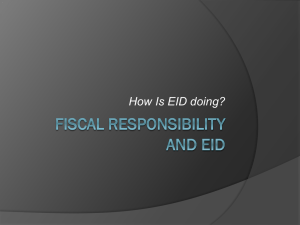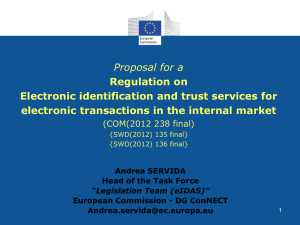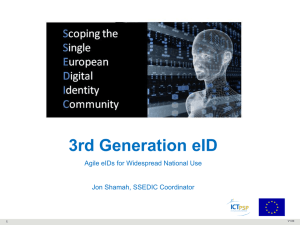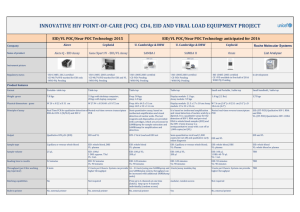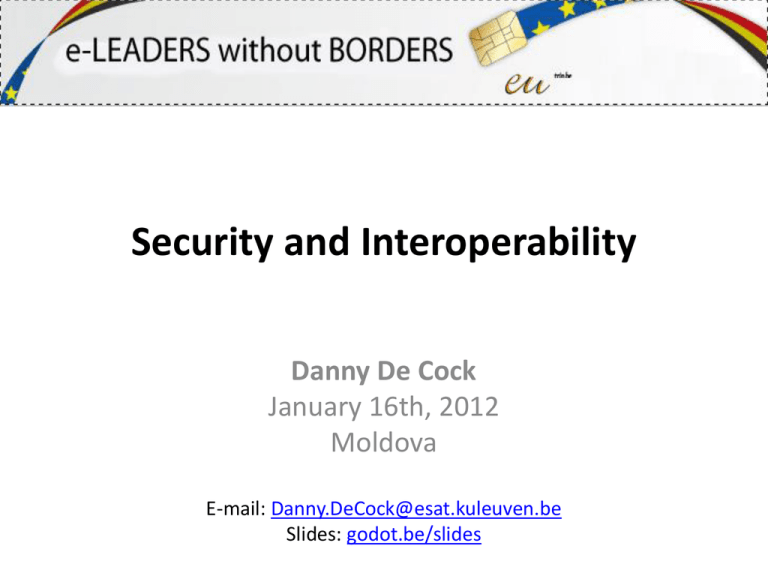
Security and Interoperability
Danny De Cock
January 16th, 2012
Moldova
E-mail: Danny.DeCock@esat.kuleuven.be
Slides: godot.be/slides
Secrets of Successful eID
Environments
• 3 High-level actors
• Different sectors
– eGovernment
Citizen/Customer
Government
Business
• Collect and store data once, reuse where possible
– eHealth
• Make patient records available to health care service
providers
– eCommerce & eBusiness
• Provide ability to correctly identify involved parties
– Avoiding online fraud, preparing effective anti-spam measures
Secrets of Successful eID
Environments
• Success depends on joined forces of public and
private sector
– Private sector requires return on investment (ROI)
• Number of contacts between a citizen and its eGovernment only
does not justify huge investments
– Public sector prefers eID enablers for use in public and
private sector
• Avoid reinventing the wheel
– Need to exchange of experience with successes and
*failures*
– Risk of lacking focus to create interoperable solutions
• Caveat: Systems focusing on any single sector are inherently
incompatible with *similar* systems
Design Decisions – Basic Concepts
• Federated architecture
– Each sector operates autonomously
– Interfaces with other sectors through bus system
• Built around authoritative sources
– Master copy of data is available at exactly one repository
– Master copy = authoritative source
• Maximal reuse of information
– No data replication
– Administrations cannot re-request data already available
• Integrated system for user and access management
– eID for all – Citizens & organizations
– Autonomous management of access & use policies
Design Decisions – Benefits
• Guaranteed interoperability enhances security!
– Modularity respects each organization’s sovereignty
• Prevents vender-lock-in
– Exchanging information using standard and open protocols
and data formats
• Guaranteed flexibility
– Modularity allows updating and following
• Security standards
• Good/best practices
Identification & Authentication
• Unique identification of
– Citizens
– Professionals
– Companies and other Service Providers (public and
private sector)
• eID for all: Authentication & Identification
tokens
– Federal token
– eID card – Belgian citizens & foreigners
– Other tokens – companies, organizations,
individuals
eID Card Types
Citizens
Kids
Aliens
eID card
Kids-ID
Foreigners’ card
eID Card Content
PKI
Citizen Identity Data
ID
ADDRESS
RRN
SIGNATURE
RRN
SIGNATURE
Authentication
Signature
Root CA
CA
RRN
140x200 Pixels
8 BPP
3.224 Bytes
RRN = National Register
eID Card = 4 Functions
• Non-electronic
1. Visible Identification of a person
• Electronic
2. Digital identification
Enabler of
eServices
• Data capture
3. Prove your identity
• Authentication signature
4. Digitally sign information
• Non-repudiation signature
eFunctionality
Levels of Assurance (LoA) of
Authentication
• Federated identity management model
– E.g., Shibboleth, Liberty Alliance, CardSpace…
LoA 4+
(qualified plus biometric)
Setting access policies
LoA 4
(qualified cert with smart card EAL4+)
Sensitive medical records (e.g. HIV),
Consultant notes containing opinions.
Ability to Break the Glass. Bank to bank
transfers
LoA 3
(2-factor authentication, non-qualified
cert, EAL4 smart card)
Patient confidential records (nonsensitive)
LoA 2
(one time password)
Some Internet banking applications
System administration
LoA 1
(uid/password, Verisign Class 1 cert)
Retrieve degree certificate. Completing
public service employment application
LoA 0
(no authentication)
Public data
eID – Level 3 + 4
Citizen’s Federal Token – Level 2
How to Choose a Security Level?
• Responsibility of the service provider under
supervision of the Privacy Commission
• Based on risk assessment and depending on
– Type of processing: communication, consultation,
alteration,…
– Scope of the service: does the processing only concern the
user or also concern other persons ?
– Degree of sensitivity of the data processed
– Possible impact of the processing
• In addition to right security level
– Use of an electronic & time-stamped signature might be
needed
Interoperable & Secure by Design
• Mandates & authorization credentials based on open
standards, e.g.,
– XACML
– SAML
• Revocation services setup by mandate manager and
certification authority
– OCSP
– CRL
• Certificates, Signatures and timestamps, e.g.,
– X.509
– XADES-*
• Communication protocols
– SSL/TLS
XAXML – Allow/Deny Service Requests…
Policy Enforcement Point
Joe
Service Provider
6
1
Execute
Service Y
OK
Execute Service Y
Check Policy Compliance
2
5
Permit / Deny Service Request
Authorization Domain
3
4
Retrieve Relevant
Policies
Policy Decision Point
Policy Access Point
Retrieve Policy
Validation Information
Policy
Information
Point
Generic Policy Enforcement Model
XACML-based
Action on
application
DENIED
User
Action on
application
Policy
Enforcement
(PEP)
Decision
Request
Policy
Retrieval
Action on
application
PERMITTED
Application
Decision
Reply
Information
Request/Reply
Policy Decision
(PDP)
Information
Request/Reply
Policy
Management
Policy Administration
(PAP)
Policy Information
(PIP)
Policy Information
(PIP)
Authentic Source
Authentic Source
Manager
Policy
Repository
Slide inspired by Frank Robben
Re-using Architecture
Be-Health
USER
Social sector
(CBSS)
USER
APPLICATIONS
Authen tication
Authorization
PEP
WebApp
XYZ
Role
Mapper
Role
Provider
Role
Provider
DB
Non social FPS
(FedICT)
APPLICATIONS
Authen tication
Authorization
PEP
WebApp
XYZ
Role
Mapper
Role
Mapper
DB
PDP
USER
APPLICATIONS
Authen tication
Authorization
PEP
Role
Mapper
DB
Role
Mapper
DB
PDP
PAP
‘’Kephas’’
Role
Provider
Role
Provider
DB
PIP
PIP
PIP
PIP
PIP
PIP
Attribute
Provider
Attribute
Provider
Attribute
Provider
Attribute
Provider
Attribute
Provider
Attribute
Provider
DB
Mandates
RIZIV
DB
XYZ
DB
Mandates
UMAF
DB
XYZ
Management
VAS
WebApp
XYZ
Role
Mapper
PDP
PAP
‘’Kephas’’
Management
VAS
Role
Provider
Role
Provider
DB
PIP
PIP
PIP
Attribute
Provider
Attribute
Provider
Attribute
Provider
DB
Bailiffs
DB
XYZ
DB
XYZ
PAP
‘’Kephas’’
Management
VAS
Slide inspired by Frank Robben
Conclusion
• eGovernment Services are accessible
– Via open standards
– With strong authentication & access management
• Federated system permits use of common
basic services securely
– Without losing any autonomy!
• System allows permanent evolution
– Continuously changing user & organization
requirements
Food for Thought
• Trust is Good – Control is Better!
Th@nk you!
Danny De Cock
Researcher Applied Cryptography
Danny.DeCock@esat.kuleuven.be
Slides: www.godot.be/slides
© fedict 2011. All rights reserved
eID Card Issuing Procedure
Card Personalizer (CP)
Card Initializer (CI)
(5)
(4)
(6)
(10a”)
National
Register (RRN)
(10a’)
(8)
Certification
Authority (CA)
(9)
(3)
(7)
Municipality
(2)
(0)
(10b)
Citizen PIN & PUK
(11)
Face to face identification
(12)
(1)
Citizen
(13)
eID Certificates Hierarchy
2048-bit
RSA
2048-bit
RSA
1024-bit
RSA
Card Administration:
update address, key
pair generation, store
certificates,…
Certificates for
Government web servers,
signing citizen files, public
information,…
Abstract eGovernment Ecosystem
A
F
C
Context 1
E
D
B
H
Introducting Belgian eID Cards & eGovernment
Context 2
Context 3
G
Slide 24
9 April 2015




